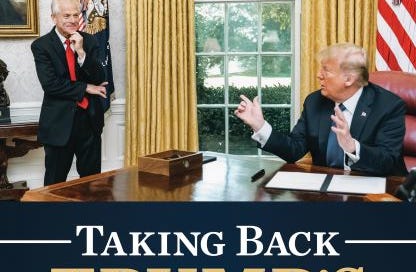Implementing Trump’s border and trade policy agendas
First 100 days will be crucial in Washington swamp
Team,
Spent the final weeks on the Trump bus tour and in rallies with the Boss in Georgia, North Carolina, Pennsylvania, and Michigan. The excitement was palpable so the result last night was no surprise.
Here’s my thoughts on what’s next, as published in the Washington Times!
All my best,
Peter
P.S. Please share with a friend and restack!
Implementing Trump’s border and trade policy agendas
Now that Donald Trump has won the historic 2024 election, he will aggressively pursue a policy agenda designed to rapidly fulfill every campaign promise he has made — see my book “The New MAGA Deal” for the 100 actions in 100 days he is likely to take.
Yet, for those who expect an overnight miracle, it is important to understand how the Washington swamp works and why it will seek to block Mr. Trump’s agenda.
Here’s what you need to know:
The Trump agenda will necessarily be implemented in two phases: (1) the proverbial first 100 days dominated by executive orders and (2) the first year (or more) thereafter featuring sweeping regulatory changes and new laws.
What distinguishes these two phases is the need — or lack thereof — for the Senate to confirm the Trump administration officials who will be critical in implementing the new MAGA deal.
Here’s the good news: Nobody in the West Wing other than the Office of Management and Budget director and Council of Economic Advisers chair needs Senate confirmation. The entire West Wing can be staffed immediately after Election Day without any Senate delay and can begin putting executive orders on the Resolute Desk in the Oval Office for a Trump signature as early as Inauguration Day.
Here’s the bad news: All 22 Cabinet secretaries and deputy secretaries, along with numerous undersecretaries and assistant secretaries, must undergo a protracted and uncertain Senate confirmation process that is likely to take well beyond 100 days and up to a year or more to complete.
Such delays would not be unique to a second Trump term. It took 100 days to confirm 22 of Mr. Trump’s 24 Cabinet-level positions. Yet only five deputy secretaries were confirmed in those first 100 days.
As an example of how a hostile Senate can block a president on key issues, it took 111 days for Mr. Trump to get his U.S. trade representative, Bob Lighthizer, confirmed despite the importance the president had attached to his trade policies and cracking down on China.
President Biden fared no better, with only 18 of 23 Cabinet-level positions and 10 deputy secretaries confirmed. Together, Mr. Trump and Mr. Biden faced massive vacancies at the undersecretary and assistant secretary levels that stretched well into the second and third years of their terms because of Senate shenanigans.
It was not always like this. The Reagan and George W. Bush Cabinets were largely confirmed in the first month. Franklin D. Roosevelt and George Washington filled their Cabinets within days.
In a second Trump presidency, expect Senate Democrats to use legislative maneuvers such as holds, extended debate and committee obstruction to slow-walk the Trump Cabinet as they did in 2017. Expect at least a few anti-tariff, open-border Republican senators to use the same tools to block key appointments at Cabinet agencies involved in securing the border and implementing Trump tariff policies.
Note: A Trump-friendly Senate majority leader such as Rick Scott could ameliorate at least some of this intraparty warfare as both John Thune of South Dakota and John Cornyn of Texas are staunchly anti-tariff and initially opposed Mr. Trump’s 2024 candidacy.
It follows that 99% of what Mr. Trump will accomplish will be done in the first 100 days through executive orders and presidential memorandums. These will be crafted by presidential appointees in the West Wing who do not require Senate confirmation.
The White House chief of staff, the directors of the National Economic Council, Domestic Policy Council and National Security Council, the White House legal counsel and the staff secretary responsible for moving executive actions to the president’s desk will be of paramount importance. This is why the appointments of these key personnel must be swift and right.
This was not how things went while Mr. Trump was in office. All four of his chiefs of staff opposed his trade and border policies, as did his first White House legal counsel, Don McGahn, and first OMB director, Mike Mulvaney.
Both of Mr. Trump’s National Economic Council directors, Gary Cohn and Larry Kudlow, were staunchly anti-tariff, as were Trump’s two Domestic Policy Council directors. Meanwhile, his two staff secretaries, Rob Porter and Derek Lyons, repeatedly slow-walked or diluted his trade and border initiatives.
2024 should be different. There is a core of trusted Trump loyalists and West Wing veterans from Main Street rather than Wall Street who could step into these critical roles and make sure the Trump policy agenda gets out of the gate fast and hits the mark of 100 actions in 100 days outlined by the president at numerous rallies.
Of course, there are an equal number of Wall Street denizens and Republicans in name only jockeying for each of these roles.
As the boss says, “let’s see what happens.”
• Peter Navarro served as Donald Trump’s manufacturing czar and chief China hawk. He is the author of “The New MAGA Deal: The Unofficial Deplorables Guide to Donald Trump’s 2024 Platform.” Follow him at www.peternavarro.substack.com.




Will you be joining President Trump’s administration again? Hope so!
UNITE WITH GOD, ONE NATION UNDER GOD, PRAY AND PREP -- REPENT